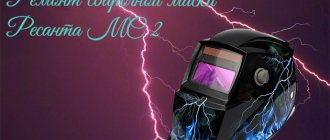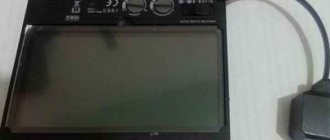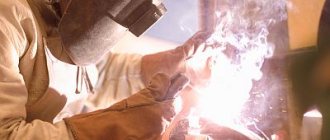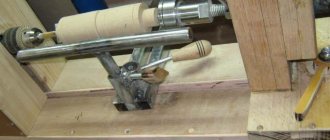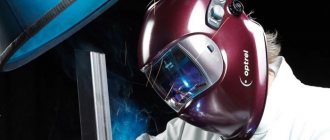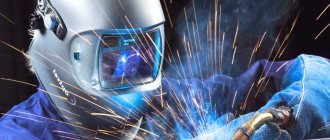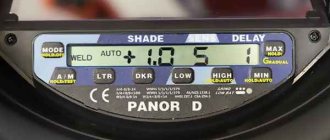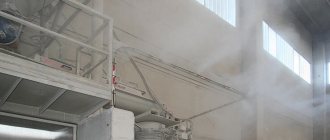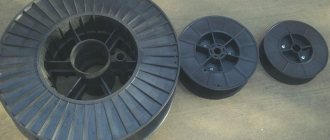The “Chameleon” welding mask got its name thanks to the filter, which automatically darkens as the intensity of the light flux increases. This significantly facilitates the welding process and makes it more comfortable than with old-style masks. Until welding begins, the filter is almost transparent, but as soon as the welder ignites the arc, the mask automatically darkens, protecting vision from burns. The characteristics of this mask largely depend on the light filters used for welding masks. Let's consider this issue in more detail.
Types of filters
The main purpose of light filters for a welder's mask is to protect the eyes from ultraviolet and infrared radiation, thermal effects and metal splashes during welding. Various filters cope with this:
- Colored glass;
- With automatic dimming;
- Polymer.
They differ in a number of characteristics and, of course, price.
- Tinted glasses are protection with a fixed tint and are characterized by low cost. To prevent the glass from transmitting harmful radiation, various impurities are added to it, the amount of which determines the darkness of the filter;
- Auto-darkening filters for welding helmets, or so-called chameleons, are based on a liquid crystal screen. When the brightness of the light changes, the liquid crystals rearrange, allowing the dimming to change. Modern glass contains 1-3 layers of such screens.
- Welding filters based on polymer materials can be darkened due to the special plasticity of polymers.
“Chameleon” masks are created using a combined scheme: glass is combined with a polymer film, which increases the level of protection from mechanical damage.
How to choose a Chameleon mask and how to check it when purchasing
A welder's mask is necessary for everyone who uses welding equipment.
From this article you will learn: how to choose a “Chameleon” welding helmet and how to test it without welding before purchasing, what to look for when choosing and much other useful information
Before purchasing a mask, you should carefully read its passport. Even a very simple mask with an automatic light filter (ASF) has a passport, which indicates its degree of darkness, recommendations for the type of welding (MIG, MAG, MMA, TIG) and the type of battery.
How to choose a welding mask? Read more about all the intricacies of choice further in our article.
Light filter "Chameleon"
The light filter for the Chameleon welding helmet represents a symbiosis of the latest achievements in microelectronics, optics, liquid crystal technology and solar panels. This filter is a multilayer element, which contains the following components:
- Liquid crystal cells. The more there are, the better the quality of the glass;
- Filters that do not transmit ultraviolet and infrared radiation;
- Polarizing film;
- Welding arc location sensors. As a rule, there are 2-4 of them. A filter with a large number of similar sensors is preferable;
- Protective glass;
- Power supplies. These can be lithium batteries, solar panels, or a symbiosis of these sources.
An important advantage of this filter is that if the arc detection sensors do not have time to operate and darken the mask, harmful radiation will still not penetrate the glass. Therefore, when choosing such a mask, it is important to pay attention to the quality and availability of such filters.
Setting based on welding mode
Diagram of the front glass of the chameleon mask.
The customizable chameleon welder mask involves the use of several operating modes. There is no need to change filters - you just need to set the required mode. The modes are designated as follows:
- MMA – manual arc welding;
- MIG/MAG – semi-automatic arc industrial welding, designed to work in a gas environment of argon or carbon dioxide;
- MIG (light) – semi-automatic gas arc welding;
- TIG, GTAW - arc welding, for which a non-consumable electrode is used;
- SAW – semi-automatic welding using flux;
- PAC – plasma arc welding.
The instructions also include information about possible breakdowns. In addition to breakdowns, troubleshooting methods are indicated. In case of complex breakdowns, it is best to contact a service center, since the equipment can be damaged, and its further repair will be expensive. If the filter darkens unevenly, you must contact a service center. The filter is out of order, and you can’t fix it with your own hands.
If flickering is observed or there is no darkening of the viewing window, then you need to carefully clean the plate of dirt. If this measure does not help, then it is best to replace the plate, since it is damaged and changing the settings will not help. If the darkening is uneven, it is necessary to remove the mask and inspect the condition of the sensors
It is important to make sure that the surface of the sensors is not blocked and that nothing prevents light from reaching them. The chameleon welder’s mask should not have any dirt stains or dust layers on the surface
Chameleon mask filter darkening selection table.
Damage to the sensors is indicated by the following:
- filter response is slow;
- the darkening does not go away after the arc goes out;
- flickering is observed, the viewing window does not darken.
In this case, you cannot repair the sensors yourself; you must immediately contact a technician at the service center.
For many models, batteries can be easily replaced with your own hands. It is imperative to inspect the sensors, i.e. bring them to a bright light. This is required to ensure work safety, since the lack of darkening leads to eye injuries.
Sensors may be blocked if:
- the window begins to brighten when it is illuminated during operation;
- the dimming level does not correspond to the set mode;
- slow response;
- darkening is observed when there is no longer backlighting;
- flickering is observed.
It is easy to correct this situation: you need to clean the surface of the sensor itself and inspect the condition of the viewing window panel.
Light filters for welding helmets: markings
The darkening of the filter is measured in indicators. There are domestic and international markings, which relate to each other in a special way:
| International classification (DIN) | Russian classification (C) |
| 9DIN | C4 |
| 10DIN | C4-C5 |
| 11DIN | C5 |
| 12DIN | C6-C7 |
| 13DIN | C8 |
You often find filters marked with the letter “E”. Their selection must be made based on the strength of the welding current:
| Marking | Welding current strength |
| E1 | 30-75A |
| E2 | 75-200A |
| E3 | 200-400A |
| E4 | More than 400A |
| E5 | More than 400A in protective gas environment |
When choosing a filter, you may encounter various other markings. We suggest you familiarize yourself with the main ones, as this will help you choose the best filter for a particular situation:
- “U” means that the glass has been additionally strengthened with minerals. They protect the filter from solid particles that may enter it during welding;
- “G1/G2/G3” - this marking indicates that the glass is designed for gas welding of low/medium/high power;
- “D1/D2/D3” is placed on light filters that are designed for use near blast furnaces, glass melting machines, and forges;
- “P1/P2/P3” - metallurgical work at temperatures of 1200/1500°C;
- “B1/B2” for auxiliary work in open areas.
Selecting a filter
The modern market offers a wide variety of filters with different parameters. Our instructions for choosing a mask can help you determine the right filter:
- The first step is to decide on the type of filter. If welding is carried out regularly, then the choice should definitely be made in favor of the Chameleon;
- It is important to keep the filter size in mind. The larger it is, the better the visibility and the more comfortable the welding work;
- The chameleon light filter for a welding helmet has such an important characteristic as response time. It can range from 0.03 to 0.0001 seconds. It is worth remembering that at lower temperatures this value will increase;
- It is better to opt for a universal filter with shading 9-13DIN. Please note that many models present a maximum dimming value of 11;
- Smooth adjustment is more comfortable to use than step adjustment;
- An important characteristic of a filter is its optical class, that is, the clarity and purity of the glass.
Let's take a closer look at what the optical class of a filter is and how it is marked. This indicator is marked with four numbers separated by a slash. Each position can contain a number from 1 to 3, where 1 is the best option and 3 is the worst.
Let's consider all positions in order;
- The optical grade of a filter is an indication of how clear the vision will be through the glass. This indicator depends on the quality of the materials used and workmanship;
- Dispersion depends on the liquid crystal elements. The possible turbidity of the image depends on this indicator;
- Homogeneity indicates uniform darkness of the filter. Uniform dimming is the most comfortable;
- The angular dependence indicates the viewing angle.
Thus, the highest quality and most comfortable filter to use will be a filter marked 1/1/1/1 or 1/1/1/2, which is also approved for use by professional welders. Amateurs are recommended to purchase filters with optical characteristics of at least 2 units for each parameter.
Features of operation
Modern Chameleon type filters require special handling, as they are quite fragile:
- The filter is afraid of sudden mechanical influences. You should not throw the mask or knock on it;
- Glass is cared for using a soft cloth, which, if necessary, can be moistened only with clean water;
- It is important to note that these filters have the ability to “slow down” at sub-zero temperatures. As a rule, at temperatures below -5°C, the filter response speed noticeably decreases. This must be taken into account when using the mask in winter.
Let's sum it up
At the moment, there are various light filters for welding helmets - from cheap tinted glasses to ultra-modern automatic filters like Chameleon. Depending on the quality of the mask, the quality and comfort of the welding work performed mainly changes.
The selection of a welding filter should be made taking into account its characteristics, which are presented in the form of special markings. It indicates for what welding and current strength a particular filter is suitable. An important characteristic of protective glass is its optical performance. When purchasing a welding helmet, it is also recommended to familiarize yourself with the relevant quality certificates. This will help you make the right choice and get high-quality protection for welding work.
What does the market offer?
All welding helmets available on the tool market can be divided into three groups based on price-quality ratio:
- The cheapest, but with a very wide range of product quality fluctuations. Often they do not have certificates. These are mainly made in Taiwan or China.
- More expensive and quite high quality. They have proper Russian certificates. These are products from domestic manufacturers or South Korea.
- The most expensive and high-quality welding helmets are chameleon. As stated in the reviews of those who chose them - with a high degree of reliability. They have all the necessary documents. These are masks produced in European countries or under the direct control of European manufacturers (for example, TECHMEN or SPEEDGLAS).
In any case, no matter how expensive and outwardly reliable the mask may look, if during operation the eyes become irritated or a burning sensation appears, then this mask is not suitable for use. Her filter needs replacing.
